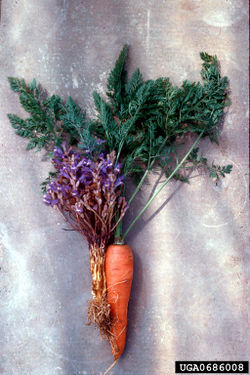Phelipanche aegyptiaca (weed)
| Literature database |
|---|
| 105 articles sorted by: |
| • year (descending) |
| • research topics |
| • countries/regions |
| • affected crops |
| • list of natural enemies |

Author(s): Reuven Jacobsohn, Agricultural Research Organization, Israel
Source: IPM Images

Author(s): Reuven Jacobsohn, Agricultural Research Organization, Israel
Source: IPM Images
Phelipanche aegyptiaca (weed) Pers. - (Egyptian broomrape)
This holoparasitic plant causes severe damage to tomatoes, legumes and other crops in the Mediterranean region. The most frequently attacked crops apart from legumes are tomato, sunflower and carrot. The tiny seeds (less than ½ mm large) germinate only after several days of moist and warm conditions. In addition, specific chemical stimuli (strigolactones) released by the host plant are required. The right temperature is the most important component of the germination process.
The radicle of the germinating seed needs to make contact with a root of the host plant within a few days after germination. If this contact is successful, a haustorium is formed which enables the tapping of water and nutrients from the host's vascular system. Eventually the parasite produces a shoot that emerges from the soil and forms numerous flowers. After pollination, capsules with seeds develop as fruits. Each plant produces hundreds of thousands of seeds which remain viable in the soil for many years.
For a review on this broomrape and its control see Eizenberg & Goldwasser (2018).
Synonyms:
Orobanche aegyptiaca
| Vernacular names | |
|---|---|
| • Deutsch: | ägyptische Sommerwurz |
| • English: | Egyptian broomrape |
| • Français: | orobanche égyptienne |